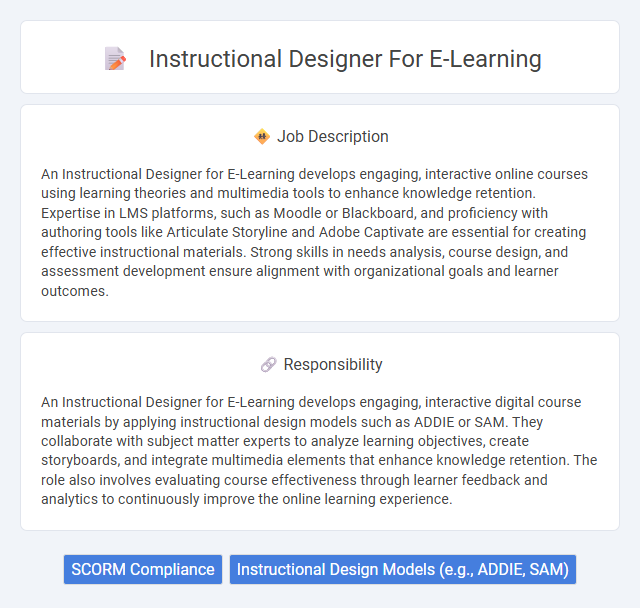
An Instructional Designer for E-Learning develops engaging, interactive online courses using learning theories and multimedia tools to enhance knowledge retention. Expertise in LMS platforms, such as Moodle or Blackboard, and proficiency with authoring tools like Articulate Storyline and Adobe Captivate are essential for creating effective instructional materials. Strong skills in needs analysis, course design, and assessment development ensure alignment with organizational goals and learner outcomes.
Individuals with strong communication skills and a passion for technology are likely to be well-suited for an Instructional Designer role in E-Learning. Those who thrive in collaborative environments and enjoy creating engaging, educational content may find this job fulfilling. However, people who prefer routine tasks or work that requires minimal creativity might face challenges adapting to the dynamic nature of instructional design.
Qualification
Instructional Designers for E-Learning typically possess a bachelor's degree in Education, Instructional Design, or a related field, with many holding advanced certifications such as CPLP or AECT. Proficiency in e-learning authoring tools like Articulate Storyline, Adobe Captivate, and LMS platforms such as Moodle or Blackboard is essential. Strong skills in curriculum development, learning theory application, and multimedia design enhance their ability to create engaging and effective online training materials.
Responsibility
An Instructional Designer for E-Learning develops engaging, interactive digital course materials by applying instructional design models such as ADDIE or SAM. They collaborate with subject matter experts to analyze learning objectives, create storyboards, and integrate multimedia elements that enhance knowledge retention. The role also involves evaluating course effectiveness through learner feedback and analytics to continuously improve the online learning experience.
Benefit
Instructional Designers for E-Learning likely enhance course engagement by creating interactive and tailored educational content, improving learner retention and satisfaction. Their expertise in applying pedagogical theories probably results in efficient learning paths that save organizations time and resources. Most employers may benefit from increased training effectiveness and measurable performance improvements when employing skilled designers in this role.
Challenge
The role of an Instructional Designer for E-Learning likely involves navigating complex learner needs and rapidly evolving technology platforms. Challenges may arise in creating engaging, accessible, and effective digital content that caters to diverse learning styles and keeps pace with educational trends. Balancing creativity with technical constraints and deadlines often tests problem-solving and adaptability skills.
Career Advancement
Instructional Designers for E-Learning leverage expertise in curriculum development, multimedia integration, and learner analytics to create engaging and effective online courses. Mastery of authoring tools like Articulate Storyline and Adobe Captivate enhances career progression opportunities within corporate training, higher education, and government sectors. Advancing into senior roles often requires skills in project management, data-driven instructional strategies, and leadership in cross-functional development teams.
Key Terms
SCORM Compliance
Instructional Designers for E-Learning specialize in creating engaging, interactive courses that adhere to SCORM compliance standards, ensuring seamless integration with Learning Management Systems (LMS). Mastery of SCORM protocols enhances content interoperability, tracking, and reporting capabilities, critical for delivering consistent learner experiences across platforms. Expertise in authoring tools like Articulate Storyline, Adobe Captivate, and experience with xAPI further supports SCORM-aligned course development and effective e-learning deployment.
Instructional Design Models (e.g., ADDIE, SAM)
Instructional Designers for E-Learning expertly apply models such as ADDIE and SAM to structure effective online courses, ensuring systematic analysis, design, development, implementation, and evaluation. The ADDIE model facilitates a linear, phase-driven approach, promoting thorough needs assessment and iterative refinement, while the SAM model emphasizes agility and rapid prototyping to enhance learner engagement. Proficiency in these instructional design frameworks enables the creation of adaptive, learner-centered e-learning solutions aligned with educational goals and technology integration.
 kuljobs.com
kuljobs.com